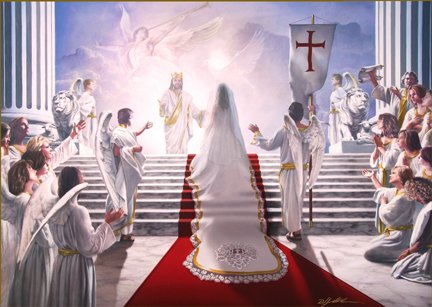
A lot of things in Revelation are not for speculation. To be true to the meaning of the metaphors and symbols used in this concluding book of the New Testament, we have to take Speculation out of Revelation.
The author John wrote this: “I testify to everyone who hears the words of the prophecy of this book: if anyone adds to them, God will add to him the plagues that are written in this book” (Rev 22:18). This is a very strong word of caution against all sorts of speculations.
Instead, we should be like Mary mulling over the word of God when the Angel Gabriel first revealed to her that she would have a son, whose name will be as Hebrew suggests, יְשׁוּעָ means, ‘Saviour.’
Mary did not jump to the conclusion like the zealots, who were looking for a political deliverer. When Jesus entered Jerusalem on a colt, the people shouted, “Hosanna!” (which in Hebrew, means, ‘Deliver us, please!’). Understandably, living under the oppression of the Romans, they were looking for a Gideon-like deliverer.
Instead, I can imagine Mary carefully thinking through the words of Gabriel for the next 33 years as to how the prophecy would be fulfilled. Each time she looked at the boy Jesus, and even to the moment when water was turned into wine at the wedding in Cana, Mary would be asking, “Is this how the prophecy is taking shape?”
At the cross, Mary was still mulling over what the angel Gabriel had told her. Her heart was broken, yet she kept the word in her heart; she was not being dogmatic about the way how the prophecy should be fulfilled.
How we should read Daniel and Revelation

When we mull over the two apocalyptic books – Revelation and Daniel – we should remain watchful, prayerful, and pondering over the exact words. For many generations, people have read these two books and had expected these things to happen during their generations.
These generations have come and gone but a lot of the things revealed in the last book of the Bible did not come to pass in their generation. Although some had expected Adolf Hitler to be the antichrist, we know that Hitler never became a world leader.
Worse still, others like the American cult leader and self-professed faith healer, Jim Jones started a farm at Jonestown, Guyana, and later orchestrated mass suicide of a few hundred followers on November 18, 1978. I hope history is not repeating itself when during one of his messages of the book of Revelation, a Singaporean preacher spoke with certainty when the Lord will return based on his study of the seasons, and for reasons known only to himself, he proposed to purchase a farmland in Thailand.
Too much has been said about the prophecies in Revelation, and how they are being “fulfilled” today. People like Nostradamus shared all kinds of vision, Michael Drosnin’s Bible Code discussed all sorts of conspiracies and speculations, and of late, Steve Ciocciolanti used his Divine Code to predict that Donald Trump would win the US presidential election.
I remember reading another book some 20 years ago, which predicted that the European Union was the ‘ten horns’ in Revelation 12. The author had made such claims because there were ten nations in the EU, but since then, more countries have been added to the block.
Within the past year, due to the extensive use of Zoom, a lot of people have also been exposed to teachings such as the gematria and pictorial Hebrew which are also used by certain individuals to predict the future. I remember sitting in a session where a teacher spoke about earth-shaking changes in 2020 as the Year of the Mouth (peh in Hebrew is mouth). These are nothing but like modern-day feng shui masters who do exactly the same. Because they are often vague with their predictions, the same can be interpreted in any way.
This is not how we should approach the apocalyptic books of the Bible. Reading Luke 2:15-20, we cannot help but to observe again how Mary pondered the feedback she received from the shepherds:
15 When the angels had departed from them into heaven, the shepherds began saying to one another, “Let’s go straight to Bethlehem, then, and see this thing that has happened, which the Lord has made known to us.” 16 And they came in a hurry and found their way to Mary and Joseph, and the baby as He lay in the [l]manger. 17 When they had seen Him, they made known the statement which had been told them about this Child. 18 And all who heard it were amazed about the things which were told them by the shepherds. 19 But Mary treasured all these things, pondering them in her heart. 20 And the shepherds went back, glorifying and praising God for all that they had heard and seen, just as had been told them.
We may not see the entire Revelation unfolded in our lifetime, but I believe that if should happen in our generation, the Holy Spirit would whisper this into our ears just as He did to Simeon and Anna, provided we have been pondering over the exact words in which they were written (see Luke 2:25-38).
Adopting an Open Mind

There are different possible interpretations of the prophecies that we read in Daniel and Revelation. This is based on our limited knowledge and the nature of these prophecies that are meant to remain a mystery until they are unfolded before our eyes.
It is said that change is the only constant. Isaiah had put it in a different way, “The grass withers, the flower fades, but the word of our God stands forever.” To interpret Revelation by speculating the signs of the times is, therefore, a form of eisegesis. This, we have to be very careful!
We all know that there are three positions relating to the rapture and the second coming of Christ. We may have a certain position we ascribe to, yet we should keep an open mind on other views as the book of Revelation is, in fact, written in three literary genres: the epistolary, the apocalyptic, and the prophetic. Our time is better spent meditating on what is written, than arguing over which view is more accurate.
Even the epistolary passages in Revelation 2 and 3 about the seven churches have several possible interpretations. Besides referring to them as seven physical churches in Asia Minor to whom John wrote to, these chapters have also been interpreted as the seven phases of the Christian church through the centuries.
There is another view which I propose after reading these words in Greek, “Μετὰ ταῦτα εἶδον” (Revelation 4:1), where John shifts his attention to a new scenario, “After these things I saw…” Bearing in mind that the word ‘church’ is no longer mentioned until Revelation 22:16, could this mean that the seven golden lampstands represent the entire Church Age as one era, with all the weaknesses that needed to be addressed, until the fullness of time when she becomes the bride of Christ, rather than just the seven phases or seven physical churches in Asia? Could this be another possible interpretation? Well, why not!
We cannot be too dogmatic about any speculation or interpretation. The important thing is we have to keep mulling over God’s word and not seek to interpret Revelation by every world event into it. When it is time for us to see the apocalypse unfolded before our eyes, God’s Spirit will bring His word to mind. Let us adopt this attitude when we read Revelation.
In the coming months from May 8 – July 31 for 13 consecutive Saturdays (10am-12pm), Dr. Chew Weng Chee will be starting a series on the book of Revelation. This will be on an online webinar. Registration opens from March 20, at https://sibkl.org.my/revelation.
|Share The Good News|




Leave a Reply